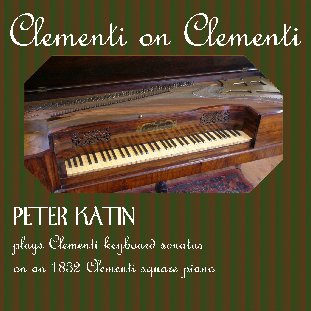There are some whose enjoyment of
performances centres on the sonorities chosen by the composer:
how things sounded
with even temperament, how certain things took on “dark” tones
while others — the eternally sunny key of C — have a far
brighter tone. Some far prefer performances on modern instruments
with stronger, more vivid timbres and notes that don’t sound ‘plinky’ or
out of tune. Peter Katin here lays out a case for the square
piano to be seen as many today see the harpsichord or clavichord:
as offshoots of the overall development of the keyboard instrument.
The square piano has its own specifically tailored
literature. Clementi’s family made square pianos and the
music Clementi composed for piano takes such limitations
in its stride. My grandfather and uncle - and my uncle
has a
square piano - would argue that in all likelihood, if Clementi
had a square piano and a modern grand in front of him Clementi
would have chosen the grand. There are definite limitations
to the instrument’s capability. The action is less precise
and noisier, with whirrings and clicks. The tone is an intermediate
step from the clavichord, with a bell-like upper register.
Katin altered his decision on which sonatas to include
once he began using the instrument on this recording — a
rosewood piano from 1832 manufactured by the Clementi family
firm. These sonatas wouldn’t necessarily be the first ones
that would come to mind from Clementi’s output. The disc
begins with the quiet and unassuming Op. 25 no. 5 in f-sharp
minor. This was a conscious choice designed to bring out
the sonorities and timbre peculiar to this type of instrument,
especially with its trademark use of thirds in the upper
register in the first and last movements. The elegiac
andante is
a lovely movement on any piano, and Katin’s playing is a
treat to hear.
The second sonata offered is the cheerful and Mozartean
Op. 24 no. 2. This is sunny, extrovert and engaging, sharing
thematic elements in its first and last movements. These
serve as bookends to the contemplative but no less positive
slow movement. The g-minor sonata Op. 7 no. 3 is the first
departure from score indications, perhaps as a nod to the
limitations of the instrument. The first movement is not
an
allegro con spirito but a
moderato, almost
andante.
While this brings out the singing nature of the instrument,
it may not be quite what the composer intended. After the
ending of this first movement, the
Cantabile e lento seems
not that much slower. This
Cantabile is almost four
minutes of reverence and beauty followed by a
Presto that
does well at showing off the Clementi square piano’s capability.
That said, the sound of the action in the quicksilver runs — something
like twigs snapping — under the lid of such a rare instrument
can be rather alarming.
The last example is from the list of “likely Clementi
sonatas”. It is the most Beethovenian of the set and has
an unsettled quality in spite of aspects that at times could
almost be seen as cheerful. The second movement is restlessly
despondent: pauses filled with a sense of loss beautifully
brought out by Katin. The triple meter finale is wonderful
work of energy and drive but ends indecisively as if quieted
by some other impulse. This makes for an odd end to what
many period-instrument lovers will likely find an intriguing
disc.
There are not that many recordings on the square
piano. This is, as with Beethoven’s Broadwood, an opportunity
to hear how a composer’s works sounded at the time they were
written.
David Blomenberg
Previously released as Athene ATH CD4:
see
review
by David Wright
AVAILABILITY 

